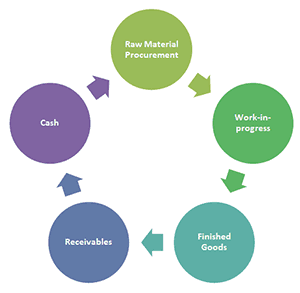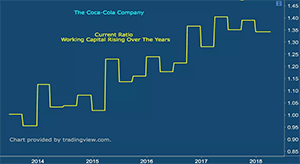Click here to get this post in PDF

Working Capital is a difficult financial concept for small business owners to understand. It is predefined as the difference between a company’s current assets and current liabilities. Working capital of a business can be measured through its operating cycle. The operating cycle examines the cycles of account receivables, account payables, and your inventory in terms of days.
Working capital financing is managed with the shortfall covered temporarily by internally generated profits or by taking loans. Most businesses require short term capital during their daily operations. Lenders usually demand collateral when you ask for a loan, so a question arises for the small business owners as to how much collateral do you need for a small business loan?
Although there are several items you can use that can serve as collateral but from the business perspective, you should choose the one that you are willing to lose in case of default, to minimize the risk. Usually, collaterals should be equal to the value of the loan that you are borrowing.
Working Capital becomes important if you are planning to expand your business. The need for growth arises if you believe that you have outgrown the physical space or if the demand of your product is increasing day by day, while you are struggling to cope with it at your current level of production. The availability of working capital is necessary if you want your business to grow.
Why is Working Capital Important
Proper management of working capital is fundamental for the financial health of a business. One of the qualities of a stable business is that it effectively utilizes working capital for growth, profitability, and to maintain liquidity.
If you are planning to grow your company, you need to ensure that you have enough liquidity when you take loans for financing the expansion. If there is low working capital, then there is a risk of not paying your debts on time, which will lead to further problems for your company.
Working Capital is a widely used tool to measure efficiency, liquidity and the financial health of a firm. Although it is extremely important to maintain it, the need for working capital varies from one sector to another, as the payback period differs from one another.
As your company grows, it can invest some of the working capital back into the business. This is done during the long-term so that when you need capital for a new project, you have the necessary funds to do that and you do not have to solely rely on banks to provide you a loan.
How Does Working Capital Affect Your Business
When people start their business, they are usually not aware of how much working capital they require for the business to be stable. If they do not plan from the beginning, they will not be satisfied with the performance of the business. One thing to note is that you should not try to expand too rapidly as that can expose you to the risk of a liquidity crisis where you would not have enough cash to pay your bills.
If this situation occurs, it would hinder the growth of your company. If it occurs during the growth period, it may lead to disastrous consequences for your company and you may have to shut down your business.
That’s definitely not a good situation to be in and may require a lot of time for your business to get out of this situation. Slow but steady growth is preferred so that your company can be built in a sustainable manner.
The following chart shows that Coca-Cola’s working capital has steadily risen over the years due to an increase in the quick ratio which depicts that the company has generally fared well in the following years.
Large companies show as much interest in maintaining working capital as much as small companies do because when they want to use external debts to finance their projects, the availability of working capital makes the loan deal cheaper due to high credit ratings. It is vital to have effective management of working capital since low liquidity may possibly lead to bankruptcy and liquidation of assets.
Management of working capital is basically a strategy with the focus of maintaining adequate balance to solve the liquidity issues.
Effects of Low Working Capital
If your business has low working capital it may lead to certain problems which are difficult to overcome. Poor management of working capital could lead to these risks:
- Bankruptcy Risk
Due to low or negative working capital, corporations use the money borrowed from creditors to finance their operations but face a risk of default. Businesses face the risk of bankruptcy due to lower earnings which would lead the company to liquidate its assets or close down which may lead to severe consequences for the owners.
- Lack of Opportunities for Investment
Organizations which have low working capital must deal with the problem of underinvestment. Investors do not trust the firms which have low or negative working balance. This shows that the management of the company is poor, and the firm is inefficient. Underinvestment may lead to big problems later since it would seriously affect the future growth of the company.
- Lack of Growth Opportunities
Since you need capital for achieving growth, low working capital would lead to no growth for your business which would have a bad impact in the future. Low working capital may hinder you from attaining the growth opportunities which would be considered as a failure for ambitious businessmen and investors.
- Trade Discounts
A lot of suppliers provide trade discounts when paid on time. Low working capital affects your payback period which will cause you to not avail these facilities and increase costs which will further decrease your working capital available.
The Wrap Up
Working Capital is an important aspect for a business if it wants to achieve growth and maintain its financial health. In the current scenario, companies may face severe losses if they do not take advantage of the favorable situation due to the stiff competition provided by competitors.
Possessing enough working capital is also necessary for the daily operations of the business; otherwise, you may have to take loans which will reduce the overall profits of your company. Firms should emphasize on effective management so that they do not face a shortfall of the working capital when required.
You may also like: 5 Ways to Reduce Your Company T&E Costs



This is a wonderful blog on the why ensure working capital availability expansion is important. Things to be considered include many options listed in this link. It is very useful article and would suggest others too. I am sure many people will come to read this in future. You have done a great research for I feel, thanks for sharing.